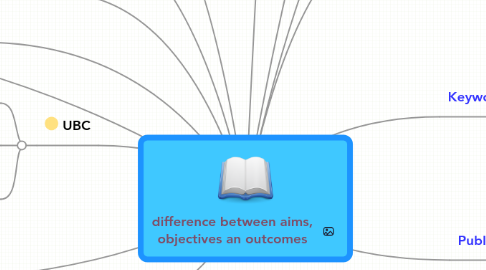difference between aims, objectives an outcomes
por Brittney Brokenshire


1. UW
1.1. (34) Linking learning objectives to assessment of learning occurs in only a few instances. UW School of Medicine is experimenting with a software package called Perception?. With the software an exam question can be linked to a specific learning objective and performance results presented in terms of learning objectives. Assessment of learning is not documented here.
1.2. (35) Existing LO may be copied and added as new LO for a different course, program, etc., with or without edits
1.3. (36) Search for LO's can occur at any point during create, modify, retire, and revise.
1.4. (37) Initiating the creation, modification, or retirement of LO's can occur as part of a larger process, such as creating a new course, or as a stand-alone process.
1.5. (38) View of exisiting LO's includes effective date and proposer name.
1.6. (39) Deleted (retired) LO is archived.
1.7. (40) When a faculty member or other authorized user creates, modifies, or deletes a course learning objective outside the new course approval process the designated curriculum administrator for the department where the course is located is notified of the change.
1.8. (41) Department administrator's approval implied by submitting change which sends the change to publish.
1.9. (42) Notifications are automatic and include reference to the specific learning objective either by text in the message or by referral to a link with the change.
1.10. (44) Learning Objectives are publishable similar to other Learning Unit (or Organizational Unit) attributes
1.11. (45) Learning Objectives can be treated as individual attributes or as a single grouped attributed in publishing; i.e., it is not "all LOs or nothing"
1.12. (47) Along with other publishing information, Learning Objectives are rendered prior to publication for reveiw
1.13. (48) Modifications to Learning Objectives appear in the appropriate publication target according to the 'refresh' timeframe established for that target (e.g., immediately, daily, weekly, quarterly, annually)
1.14. (49) Approved LOs must exist prior to keyword attachment or mapping
1.15. (28) [Approved] Learning objectives can be associated with [Approved] learning objectives at another level: course objectives mapped to program objectives, program objectives mapped to college-level objectives, etc.
1.16. (52) List of common keywords available to users.
1.17. (53) Deleted keword is not archived.
1.18. (54) For mapping, proposer is presented with LO's for organizations related to proposal CLU, i.e. proposer does not need to enter the name of the program or college when entering LO's for a course in that program and college.
1.19. (55) LO's must be able to be mapped in a multi-level hierarchy
1.20. (56) Registrar can designate words not to be included in keywords and can delete keywords from the list of keywords.
1.21. (57) Search results can be sorted according to course prefix, level of course (100-, 200-, etc.), related parent learning unit, organization, degree, etc.
1.22. (58) Search criteria include primary, secondary, and tertiary keywords.
1.23. (59) When browsing learning objectives user can select criteria such as "show me all the LOs for the BA in Chemistry" or "show me all the programs for this LO."
1.24. (60) User can search for related LOs that are mapped (have a relationship with) to the LO. User can refine this search by asking for only certain types of relationships such as course LO to course LO relationships.
1.25. (61) The content of learning objectives is not centrally mandated but instead each discipline's faculty craft learning objectives as they best represent learning within that discipline. A shared vocabulary, developed by the faculty, may be used if applicable to the discipline.
1.26. (62) Searchable keywords are identified by the users which include faculty, staff, and students. A lexicon of commonly used keywords will be created from the frequency of use
1.27. (63) Each CLU, no matter what LU type, will likely have many learning objectives and each learning objective will likely be related to several other learning objectives
1.28. (31) Ability to restrict create or revise access of Learning Objectives, Key Words, and linking LOs (with other LOs or other things)
1.29. (46) Learning Objectives can be included in the set of information that is published for a given CLU and given target
2. UBC
2.1. (25) Child learning objectives may collectively equate a parent learning objective
2.2. (22) A “key word” may be enterable by a LO author
2.3. (16) All learning objectives, once approved are available for re-use
3. Delta
3.1. (17) Learning objectives must be identifiable as Federal-government/State defined SLO, Program Learning Objective, Course Learning Objective
3.2. (18) Restrictions on how LOs relate to other LOs may be placed based on the LO types involved
3.3. (29) Learning Objectives that are associated with a course may be ‘tied’ to a goal or objective of a program or the institution
4. UMD
5. Berkeley
6. MIT
6.1. (24) A keyword may be retired by an administrator
7. NPS
7.1. (5) Course LOs are created and maintained by department coordinators
8. SHARED
9. Assigning Keywords to an LO (to improve Searchability)
10. (6) LOs are created and relationships established by faculty members and review committees
11. (13) An approved learning objective is searchable by keyword, associated learning unit, other meta data (eg. Level)
12. Proposing and Revising LOs
12.1. Authorizations
12.1.1. (8) Learning objectives need to be authored by a faculty member when proposing a course
12.2. (27) A program LO might support a LO in another program.
12.3. Associating LOs with other things
12.3.1. (1) A learning objective may be associated with any type of learning unit
12.3.2. (2) A learning objective may be institution-wide, for a college, department, or division
12.3.3. (12) A learning objective inherits some information from its associated learning units (eg. Level)
12.3.4. (26) A course LO may ‘support’ a program LO.
12.3.5. (21) A learning objective must be able to be associated with zero, one or many “key words”
